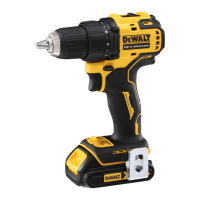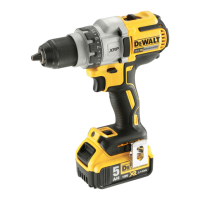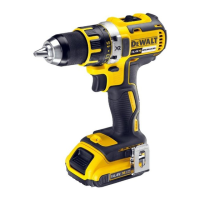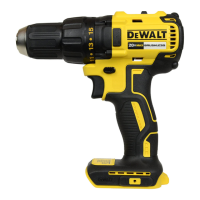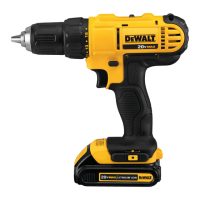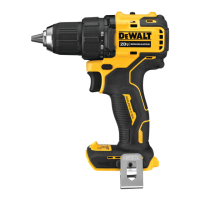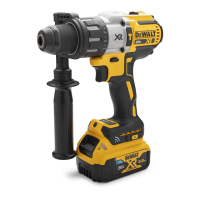21
ENGLISH
Proper Hand Position (Fig. D)
WARNING: To reduce the risk of serious personal injury,
ALWAYS use proper hand position asshown.
WARNING: To reduce the risk of serious personal injury,
ALWAYS hold securely in anticipation of a suddenreaction.
Proper hand position requires one hand on the main handle
16
and one hand on the batterypack.
Check for damage to the tool, parts or accessories which may
have occurred during transport.
OPERATION
Instructions for Use
WARNING: Always observe the safety instructions and
applicableregulations.
WARNING: To reduce the risk of serious personal injury,
turn tool off and disconnect battery pack before making
any adjustments or removing/installing attachments or
accessories. An accidental start-up can causeinjury.
Pivoting LED Worklight (Fig. A, E)
CAUTION: Do not stare into worklight. Serious eye injury
couldresult.
The worklight
5
located on the foot of the tool is activated
when the trigger switch is depressed and is adjustable via three
detent positions. The off
17
, on
18
, and spotlight
19
modes
can be changed by moving the worklight switch
13
on the foot
of tool. In the on setting, the worklight will stay illuminated for
up to 20seconds. If the trigger switch remains depressed, the
worklight will remainon.
NOTE: The worklight is for lighting the immediate work surface
and are not intended to be used as aflashlight.
Spotlight Mode
The spotlight will run for 20minutes after the trigger switch is
released. Two minutes before the spotlight will shut off, it will
flash twice and then dim. To avoid the spotlight shutting off,
lightly tap the triggerswitch.
WARNING: While using the worklight in medium or
spotlight mode, do not stare at the light or place the drill in
a position which may cause anyone to stare into the light.
Serious eye injury couldresult.
CAUTION: When using the tool as a spotlight, be sure it is
secured on a stable surface where it will not cause a tripping or
fallinghazard.
CAUTION: Remove all accessories from the chuck before
using the drill as a spotlight. Personal injury or property damage
couldresult.
Low Battery Warning
When in spotlight mode and the battery is nearing complete
discharge, the spotlight will flash twice and then dim. After two
Dual Range Gearing (Fig. A)
The dual range feature of your drill/driver allows you to shift
gears for greaterversatility.
1. To select speed 1(high torque setting), turn the tool off
and permit it to stop. Slide the gear shifter
4
forward (towards
thechuck).
2. To select speed 2(low torque setting), turn the tool off
and permit it to stop. Slide the gear shifter back (away from
thechuck).
NOTE: Do not change gears when the tool is running. Always
allow the drill to come to a complete stop before changing
gears. If you are having trouble changing gears, make sure that
the dual range gear shifter is either completely pushed forward
or completely pushedback.
Torque Adjustment Collar (Fig. A)
Your tool has an adjustable torque screwdriver mechanism for
driving and removing a wide array of fastener shapes and sizes
and in some models, a hammer mechanism for drilling into
masonry. Circling the torque adjustment collar
3
are numbers,
a drill bit symbol, and on some models, a hammer symbol.
These numbers are used to set the clutch to deliver a torque
range. The higher the number on the collar, the higher the
torque and the larger the fastener which can be driven. To select
any of the numbers, rotate until the desired number aligns with
thearrow.
Keyless Single Sleeve Chuck (Fig. C)
WARNING: Do not attempt to tighten drill bits (or any other
accessory) by gripping the front part of the chuck and turning
the tool on. Damage to the chuck and personal injury may result.
Always lock off trigger switch and remove the battery from the
tool when changingacces sories.
WARNING: Always ensure the bit is secure before starting
the tool. A loose bit may eject from tool, causing possible
personalinjury.
Your tool features a keyless chuck
6
with one rotating chuck
sleeve
7
for one-handed operation of the chuck. To insert a drill
bit or other accessory, follow thesesteps.
1. Turn tool off and remove the batterypack.
2. Grasp the black sleeve of the chuck with one hand and
use the other hand to secure the tool. Rotate the sleeve
anticlockwise (as viewed from the front) far enough to accept
the desiredaccessory.
3. Insert the accessory about 19mm into the chuck and tighten
securely by rotating the chuck sleeve clockwise with one hand
while holding the tool with the other hand. Continue to rotate
the chuck sleeve until several ratchet clicks are heard to ensure
full grippingpower.
NOTE: Be sure to tighten chuck with one hand on the chuck
sleeve and one hand holding the tool for maximumtightness.
To release the accessory, repeat steps 1and 2above.
Drill Operation (Fig. A, D)
WARNING: TO REDUCE THE RISK OF PERSONAL INJURY,
ALWAYS ensure workpiece is anchored or clamped firmly. If
drilling thin material, use a wood “back-up” block to prevent
damage to thematerial.
1. Turn the collar
3
to the drillsymbol.
2. Select the desired speed/torque range using the
gear shifter
4
to match the speed and torque to the
plannedoperation.
minutes, the battery will be completely discharged and the
drill will immediately shut down. At this point, replace with a
freshbattery.
WARNING: To reduce the risk of injury, always have a
back-up battery or secondary lighting available if the situation
warrantsit.
NOTE: The first time the tool is run after changing the direction
of rotation, you may hear a click on start-up. This is normal and
does not indicate aproblem.
